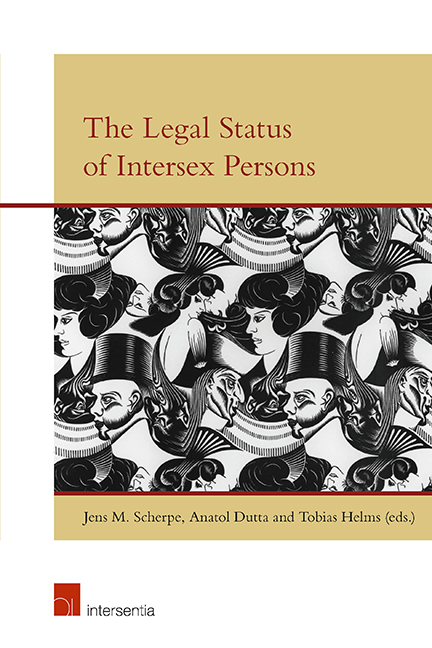Book contents
- Frontmatter
- Preface
- Contents
- List of Contributors
- The Legal Status of Intersex Persons: An Introduction
- Malta Declaration
- Darlington Statement
- Vienna Statement
- PART I MEDICINE AND PSYCHOLOGY
- PART II THEOLOGY AND LEGAL HISTORY
- PART III TRANSGENDER, TRANSSEXUALITY AND INTERSEX
- PART IV NATIONAL LEGAL DEVELOPMENTS
- PART V PRIVATE INTERNATIONAL LAW ASPECTS OF INTERSEX
- PART VI INTERSEX AND HUMAN RIGHTS
- Standing Up for the Human Rights of Intersex People
- The ‘Normalisation’ of Intersex Bodies and ‘Othering’ of Intersex Identities
Standing Up for the Human Rights of Intersex People
from PART VI - INTERSEX AND HUMAN RIGHTS
Published online by Cambridge University Press: 31 January 2019
- Frontmatter
- Preface
- Contents
- List of Contributors
- The Legal Status of Intersex Persons: An Introduction
- Malta Declaration
- Darlington Statement
- Vienna Statement
- PART I MEDICINE AND PSYCHOLOGY
- PART II THEOLOGY AND LEGAL HISTORY
- PART III TRANSGENDER, TRANSSEXUALITY AND INTERSEX
- PART IV NATIONAL LEGAL DEVELOPMENTS
- PART V PRIVATE INTERNATIONAL LAW ASPECTS OF INTERSEX
- PART VI INTERSEX AND HUMAN RIGHTS
- Standing Up for the Human Rights of Intersex People
- The ‘Normalisation’ of Intersex Bodies and ‘Othering’ of Intersex Identities
Summary
WHO ARE INTERSEX PEOPLE?
Intersex individuals are born with sex characteristics (such as chromosomes, genitals and/or hormonal structure) that do not belong strictly to male or female categories, or that belong to both at the same time.
’ Intersex'stands for the spectrum of variations of sex characteristics that naturally occur within the human species. It also stands for the acceptance of the physical fact that sex is a spectrum and that people with variations of sex characteristics other than male or female do exist.
Historically, the term ‘intersex’ was used as if it was as a disorder that needed medical intervention to ‘fix it’. In the past two decades, the term has been reframed and established by intersex human rights defenders and their organisations as the human rights-based umbrella term.
Our sex characteristics are set out from birth, whether we are intersex or not. However, the fact that someone has an intersex body can become apparent at different times in their life: at birth, during childhood, in puberty or even in adulthood. Depending on the specific life circumstances and the degree of taboo in their environment, a person might learn that they have an intersex body at a very early age or later in life. Some intersex people never find out at all.
People with an intersex body can have as many gender identities (and sexual orientations for that matter) as people with a non-intersex body. Some intersex people have an intersex gender identity.
Intersex people are still very much invisible in our society. People who do not have an intersex body and want to use ‘intersex’ to describe their gender identity, should be aware of the fact that, unfortunately, they are actually making intersex human rights violations less visible.
Being intersex does not mean that the sex of the person is unspecified/ unclear/unknown. It is only the current practice of recognising only two sexes, male and female, that leads to categorising intersex as ‘unspecific’. Equating intersex with an unclear or unknown sex is disrespectful and deprives intersex people of the rightfulness of their body. This false judgement also leads to the fact that their right to bodily integrity is often violated by unconsented medical treatments.
- Type
- Chapter
- Information
- The Legal Status of Intersex Persons , pp. 429 - 444Publisher: IntersentiaPrint publication year: 2018

